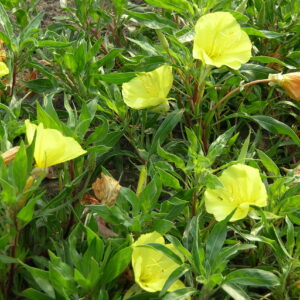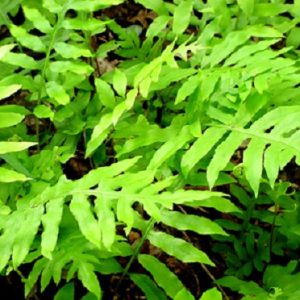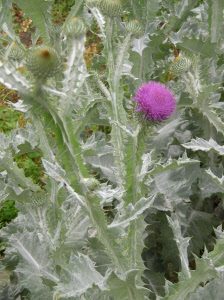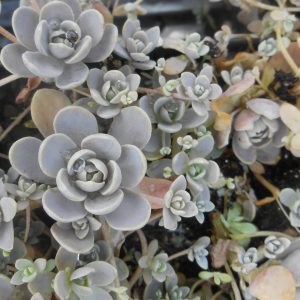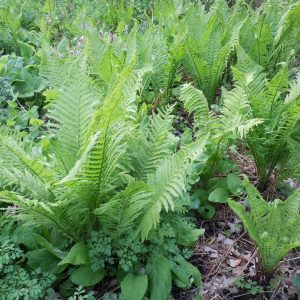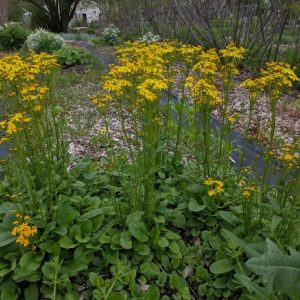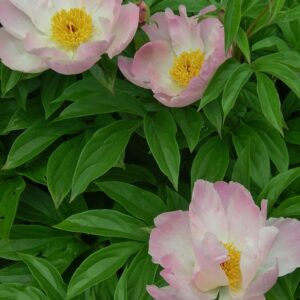Perennials & Biennials
Showing 321–328 of 511 results
-
Oenothera macrocarpa syn. O. missouriensis Ozark sundrops Z 3-7
Four wide petals form a cup of big, canary-yellow blossoms much of the summer, then turn into curious big oval seed pods
Four wide petals form a cup of big, canary-yellow blossoms much of the summer, then turn into curious big oval seed pods
Size: 9-12" x 12"
Care: sun in well-drained soil
Native: Missouri & Nebraska
Awards: Royal Horticultural Society Award of Merit.Oenothera is Greek meaning wine tasting referring to the ancient use of Sundrop roots. This discovered in 1810 by Thomas Nuttall when he traveled along the Missouri River “on the elevated summits of the …hills in the vicinity of the lead-mines of the river Meremeck, 30 miles from St. Louis, Louisiana.” (then in the Louisiana Territory). Nuttall described it as a “splendid and singular species.”
-
Onoclea sensibilis Sensitive fern Zones 4-10
Medium green fronds grow with deep curves along the wide stem then grow outward with lance-shaped fronds with wavy leaf margins. Don’t be fooled by the name sensitive. This is a tough fern growing just about any place with some shade.
Medium green fronds grow with deep curves along the wide stem then grow outward with lance-shaped fronds with wavy leaf margins. Don’t be fooled by the name sensitive. This is a tough fern growing just about any place with some shade.
Size: 12-20" x 24” spreading, slowly by rhizomes.
Care: part to full shade in moist to well-drained soil
Native: Eastern North America, Wisconsin native
Awards: England’s Royal Horticultural Society Award of Merit.Collected before 1700. Sensibilis means sensitive on account of fronds dying back when it frosts. Oneida used this for bedding when hunting. According to Oneida tradition if a woman drinks an infusion, she can never have children after she gets married.
-
Onopordum acanthium Scotch thistle, Woolly thistle Biennial Z 5-9
Soft, majestic purple-magenta thistles on prickly silver foliage and stems.
Soft, majestic purple-magenta thistles on prickly silver foliage and stems.
Can not ship to: Arizona, Arkansas, Colorado, Connecticut, Idaho, Missouri, Nebraska, Nevada, New Mexico, North Dakota, Oklahoma, Oregon, South Dakota, Texas, Utah, Washington and Wyoming.
Size: 4-6’ x 2”
Care: full sun in moist, well-drained soil
Native: Europe and western Asia
Wildlife Value: Bees, butterflies and birdsIdentified by Dioscorides in De Materia Medica for medicinal use around 70 A.D. Chosen as the symbol of Scotland by King James V. According to legend the Scotch thistle helped Scotland fend off a night-time Viking invasion by preventing a sneak attack. It caused the Vikings to scream in pain waking the Scots. Introduced to American gardens in late 1800’s.
-
Orostachys iwarenge Chinese dunce cap In China called wa song shu Z 5-10
Three-in-one: starts as fleshy silver-blue rosettes spreading to 12” across, then pyramids (dunce caps) of foliage & finally pink & white frilly flower spikes in October. Mother plant dies after flowering but its offsets survive (like Hens & chicks) plus it reseeds for more plants next season.
OUT OF STOCK
Three-in-one: starts as fleshy silver-blue rosettes spreading to 12” across, then pyramids (dunce caps) of foliage & finally pink & white frilly flower spikes in October. Mother plant dies after flowering but its offsets survive (like Hens & chicks) plus it reseeds for more plants next season.
Size: 6” x 14”
Care: sun to part shade in moist well-drained to well-drained soil
Native: China1st described in Western literature in 1878. Renamed several times – Cotyledon malacophylla var. japonica (1878), Cotyledon iwarenge, Sedum iwarenge.
-
Osmunda cinnamomea Cinnamon fern Z 4-8
OUT OF STOCK
OUT OF STOCK
Size: 36” x 24”
Care: Part shade in moist soil
Native: Eastern No. America
Awards: Royal Horticultural Society Award of Merit.The species name refers to its cinnamon-brown spore bearing stalks. Cherokee used this fern to cure snakebites by applying the chewed root to the bite. Roots cured rheumatism and chills. Cooked spring fronds made a tonic. 1st collected by Rev. John Banister in colonial Virginia c. 1680. A gunman mistakenly shot and killed him while he collected plants. Its fiddleheads are food for ruffed grouse, and hummingbirds sometimes use the fuzz on young fronds to line their nests.
-
Osmunda regalis Royal fern Z. 4-10
Lance-shaped double divided leaves. Late summer erect brown tassels form – they are fertile fronds
OUT OF STOCK
Lance-shaped double divided leaves. Late summer erect brown tassels form – they are fertile fronds. One of internationally known garden designer Piet Oudolf’s 100 “MUST HAVE” plants, Gardens Illustrated 94 (2013)
Size: 4-6’ x 12’
Care: Sun to Light shade, moist, humusy, acidic, fertile soil
Native: Eastern North America
Awards: Great Plant Pick Award from Elisabeth Carey Miller Botanical Garden & England’s Royal Horticultural Society Award of Merit.Osmunda named for Osmunder, a Saxon god. 1st collected by Rev. John Banister who moved to colonial Virginia in 1678. A gunman mistakenly shot and killed him while he collected plants.
-
Packera obovata syn. Senecio obovata Round-leaved ragwort, Golden groundsel Z. 3-8
Clusters of perky yellow daisies with sunny centers atop nearly leafless, erect stems blooming late spring to early summer. After flowering basal foliage makes an attractive groundcover.
Clusters of perky yellow daisies with sunny centers atop nearly leafless, erect stems blooming late spring to early summer. After flowering basal foliage makes an attractive groundcover.
Size: 1-2’ x 6-12”
Care: sun to part shade in moist to moist well-drained soil
Native: curved swath from eastern Canada to FL west to IL and NM
Wildlife Value: attracts bees. Deer resistantObovata means egg-shaped describing the shape of its basal leaves. First named in 1803 from a plant of Rev. Henry Ernest Muhlenberg (1742-1852) Pennsylvania plantsman, sent to German botanist Carl Ludwig Willdenow (1765-1812). Packera named for a Canadian botanist, John C. Packer.
-
Paeonia ‘Seashell’ Sea Shell peony Z 3-8
Blousy, single, ballerina pink petals 6” across, surround golden centers in mid-season, sweetly fragrant.
Blousy, single, ballerina pink petals 6″ across, surround golden centers in mid-season, sweetly fragrant.
Size: 36"x 36"
Care: sun to part sun in moist well-drained soil. Plant “eyes” no deeper than 2” below soil. If planted too low, it will not flower.
Wildlife Value: Deer resistant.
Awards: American Peony Society Gold Medal in 1990.Paeonia is derived from the Greek mythical figure Paeon, who Pluto turned into a flower. Theophrastus described the peony around 300 B.C. Dioscorides, 1st century A.D., claimed the root eased the pain of childbirth. During the Middle Ages peonies used in Europe to remedy the falling sickness, cleaning women after child birth, nightmares, and melancholy. The “surest way” to effect a cure was to hang fresh root around the neck. Otherwise an infusion should be taken before and after a full moon. ‘Seashell’ introduced by H.F. Sass in 1937.

